The Mahoning County Infirmary
Compiled by Wendell F. Lauth, Jennifer L. Neff, Patricia D. Wiant, 2012
Opening Remarks, 2012
Prior to Mahoning County’s creation of the Infirmary (Poor House) needy and challenged individuals were cared for by the township where they resided. In some cases reports state that people were run out of town before they had a chance to become a public charge. Also at times the county may have taken a role in the care of these unfortunates. There was a home established in Trumbull County in 1835 and prior to 1846 when Mahoning County was formed, some public charges may have been sent there.
The Mahoning County Infirmary was located on Herbert Road in Canfield Township. It was known by various names; the County Home, the Poor House and locally as the old “Pogey.” The homeless, handicapped, elderly and poor were housed there. Some stayed only a short time and some stayed until their death. There are records of women who gave birth there and it is also recorded that at times children lived in the home.
A search was initiated in deed records to establish when the Infirmary was established. Through these records it was discovered that the county home opened in November of 1855. The original proprietors of the land where the Infirmary was located were stockholders in the Connecticut Land Company. They acquired ownership in 1798. Judson Canfield sold this particular lot (lot 1, 4th division) to Otis Guild with a deed dated January 4, 1800. It is interesting to see that the land was listed in Campfield Township.
On April 18, 1811 John Harding purchased the land from Otis Guild. The deed described the property as being marked with trees with the date 1798 engraved on them. This date signifies when the surveying party first came to Canfield to lay out lots. John and his brother George Harding were early settlers arriving in 1805 from Lehigh County Pennsylvania. Both served in the Revolutionary War and are buried in Old North Cemetery in Canfield.
On September 5, 1821 John sold 131 and 62/100 acres of it to his brother George. Canfield Historical Society has this original 1821 deed which was gifted to them by Robert H. Neff, a John Harding descendant. According to the earliest of plat maps for Trumbull County in 1830, it shows John and George Harding were the owners. The 1840 plat map shows the land as part of their estates; John having died in 1838 and George in 1830. Their land was in Section 1, the 4th Division. John’s estate owned 163 acres in the north half and George’s estate owned 103 acres in the south half, which would have been where the actual Infirmary building stood. The portion of lot 1 belonging to John Harding Sr. was acquired by his son John Harding Jr. upon his father’s death. John Jr. in turn sold the land to his son George E. for $300 on May 9, 1853.
The subject of establishing the Infirmary appears in the Mahoning County Commissioner’s minutes of March 1854; however no action was taken. On April 12, 1854, the selection process of finding a suitable farm for the poor house was begun by viewing several farms in the county. At an adjourned meeting the next day, the choice was announced.
The commissioners purchased from George E. Harding 131 and 62/100 acres at $33 per acre and of George Harding (of Ellsworth) 101 and 62/100 acres for a total of 233 and 24/100 acres per $40 an acre. The commissioners hired George E. Harding for the 1854 planting season and agreed to pay him for cutting lumber, poplar and walnut, on the farm.
To furnish the Infirmary the commissioners sought bids in September 1855 for six dozen common chairs, a half dozen armed rocking chairs, five tables, and fifteen bedsteads.
Three Infirmary Directors were elected at the Mahoning County general election on October 9, 1955. For three year staggered terms, James Brown, James Jones and Manuel Hamilton were chosen.
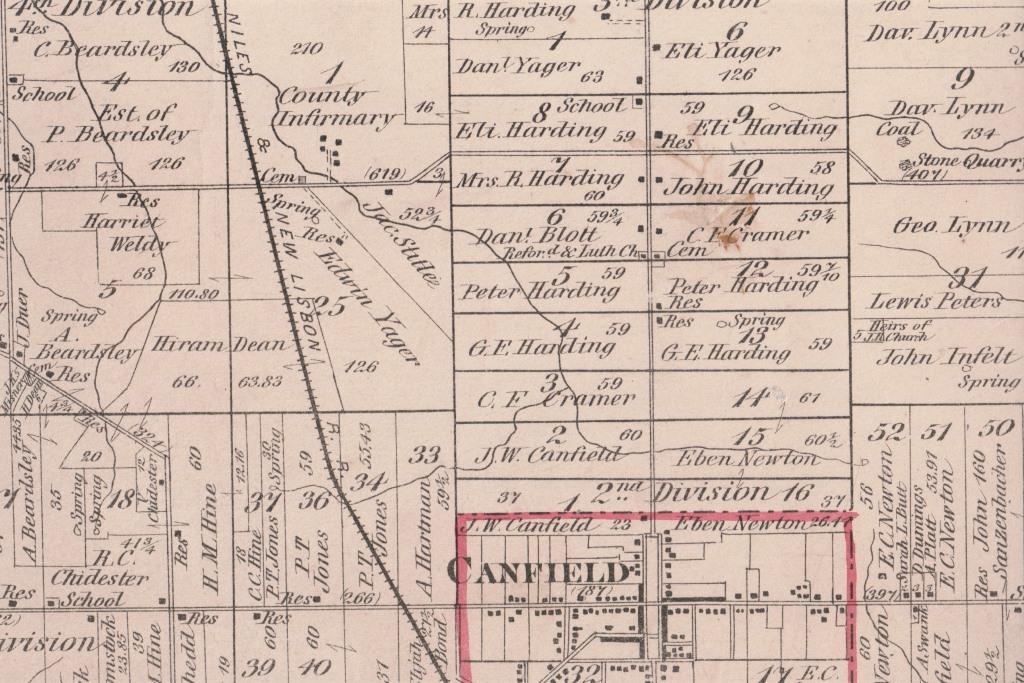
The 1874 Mahoning County Atlas contains a map which shows the location of the Infirmary cemetery.
Following is a chronologically ordered, collection of newspaper articles regarding the Infirmary.
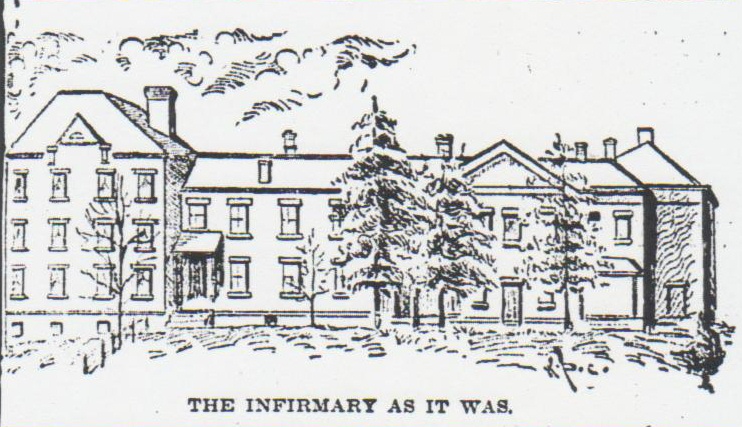
In 1897 the Infirmary was destroyed by fire.
This etching was in the Vindicator at that time.
November 1855 Opening Day
Republican Sentinel, Fri, 16 Nov 1855, p.3:4
“OPENING DAY OF THE MAHONING COUNTY INFIRMARY”
“Thursday, November 15, 1855”
“The County Infirmary”
“This important and long needed institution is finished. Last Thursday was the first ‘reception day.’ In company with a respectable number of citizens, we attended, presented our cards, were properly announced, and graciously received; but failing in being recognized as worthy of permanent location in so fine a building, the visit necessarily became a transient or ‘momentary call.’ The building is pleasantly located on a productive looking farm – is well built and well finished, doing credit to the mechanical skill of those who have built and completed it. Its exterior has a benevolent appearance generally, while its interior displays charitable features particularly, compelling the most common observer to feel proud of such institutions and of the liberality of the people who willingly furnish the means to thus provide for unfortunate humanity. It is an honor to the county. The two active directors (Messrs. Jones and Brown) and the superintendent (Mr. Shields) manifest the proper spirit of energy and interest in the management and welfare of the institution. There were eight inmates received the first day of the opening, all apparently deserving of the situation and ‘retreat’ secured.”
1855 First Occupants
Mahoning County, Ohio, Infirmary Record Book 1, 1855-1859
“Book of Entries of the Superintendent of the Mahoning County Infirmary in this State of Ohio
Milton No. 1
David Pegg died at the infirmary February 25th 1865. Received on a certificate of The Trustee of Milton Township one Dave A. Pegg, age not known nor birth place and no goods. This 18th Nov. 1855 certificate endorsed James Shields. David Pegg died at the infirmary February 25th 1865.
Canfield No. 2
Received on a certificate of the Trustees of the Township of Canfield Mrs. Daniel Duches, sixty five years of age, birth place in the State of Connecticut resides in the Township of Canfield fifty years, certificate in good health, a cripple.
Also one Harriett Chidester about forty five years of age and insane.
Also one Henry Everett about twelve years of age, birth place Canfield.
Order Endorsed by the Supt. Directors Nov. 15, 1855
Austintown No. 5
Received on the certificate of the Trustees of the Township of Austintown one John Randolph aged eighty one years more or less. Shoemaker by trade.
Also Mary Randolph his wife seventy five years old and infirm.
Order endorsed Nov. 15, 1855 John Shields (Supt.)
Poland No. 4
Received on the certificate of the Trustees of the Township of Poland Mr. Edward Hughes, insane, thirty five years of age had a legal situation before insanity. A miner by trade.
Nov. 15, 1855
James Shields(Supt.)”
1857 Inspection and Evaluation
Mahoning Register, 12 June 1857
“Canfield, May 27, 1857”
“This afternoon we visited the county poor house in company with Mr. James Jones, one of the directors. – We were informed that twenty-six were there at that time, of which number two were delirious. The rooms and bedding are neatly taken care of, and it appeared to us, that the inmates are well and suitably provided for, in every essential particular; and that the management of the institution is highly creditable to the directors, and to the county of Mahoning.
It may be unfortunate to be poor, but it is not a crime; and every civilized community deems it a duty to provide for such of its members as are unable to do it themselves. It is truly fortunate that the services of Mr. and Mrs. Shields have been obtained. The little stock on the farm is in first rate condition, the fences are in good repair, and the fields in grass look well. The wheat that was sewed last fall, has been mostly killed by the hard winter; but the ground has been judiciously stocked with clover, and other grass seed. The clover fields should be sowed with plaster, and preparations should be made during the summer, to procure sufficient time to dress the ground on which wheat is to be sowed in the fall. This would be done by a good farmer if he owned the land, and was not supplied with manure, and whenever the public business is done, as a provident man attends to his own concerns, it is well done.
One person died there lately, and the selection of a suitable site for a burying ground may be worthy of the consideration of the board of directors. The door yard fence when finished and painted will favorably add to the appearance of the house and to its beautiful locality.
The people of the county will be gratified to visit this institution, as one of great benevolence, and if strangers should accompany them, a knowledge of its good management would be extended.”
“Elisha Whittlesey, Stanly C. Lockwood, Warren Hine, Pierpont Edwards, Wm. W. Whittlesey”
Early Burials
Comment from Wendell F. Lauth, 2012: Two pieces of information show that the person who died in the infirmary at the time the above (1857) article was written was probably James Haney. His burial site is not known but it is likely that he was buried at the Infirmary.
Infirmary Record Book 1 shows James Haney being admitted to the Infirmary on 19 Nov 1855”
Mahoning Register, 4 June 1857 – Abstract
“HANEY, James – Canfield, infirmary, 12i, 86y formerly of Coitsville”
Another early infirmary death was Hannah McKasky. Again, the burial site is unknown. It appears that a record book for the first burials is missing. A gap of fifty years exists before an existing record was started in 1907. That record contains death listings to 1946.
Republican Sentinel, 7 Apr 1859 – Abstract
“McKASKY, Hannah – County Infirmary, Canfield, 74y”
Ninety Paupers Housed in 1880
Mahoning Dispatch, Fri, 30 Apr 1880
“Home and County News – The County is supporting about 90 paupers at the infirmary –Youngstown News. And the majority of them are from Youngstown, the ‘News’ might have added.”
Infirmary Farm – 1 June 1880
Productions of Agriculture in Canfield, Mahoning County, Ohio, 8 June 1880
A special addition to the 1880 U.S. Census, p. 14
Note: Listed on the same page are Lucinda Reed and son, Almus Beardsley, Peter Stittle, Almon Eastman, Peter Yager, George Harding, Charles E. Clemmens, and Sam Weldy.
Acres of Land, Farm Values, Fences, Labor
190 acres of tilled land
40 acres of woodland
?$6920 farm value including land, fences and buildings
$400 value in farming implements and machinery
$1120 value in livestock
$50 in cost of building and repairing fences in 1879
$100 in cost of purchased fertilizer in 1879
$528 amount paid for wages for farm labor during 1879 – including value of board
104 weeks hired labor in 1879 upon farm – excluding housework
$1561 estimated value of all farm production (sold, consumed, or on hand) for 1879
Grass Lands
24 acres mown, 24 in hay and 0 in clover seed or grass seed
On Hand
5 Horses of all ages
0 Mules and asses of all ages
Neat Cattle and Their Products
0 working oxen
20 milch cows, 4 other, 18 calves dropped, 0 purchased, 15 sold living, 26 slaughtered,
5 died, strayed, stolen, or not recovered
800 lbs. butter and no cheese made on the farm in 1879
Sheep and Their Products – 0 sheep and lambs
Swine – 24 swine
Poultry and Their Products
50 barnyard, exclusive of spring hatchings
400 eggs produced in 1879
Cereals, Fiber, Sugar In 1879
No barley, buckwheat, rye, flax, straw, fiber, hemp, sorghum or sorghum molasses
16 acres and 500 bushels shelled Indian corn
20 acres and 275 bushels oats
20 acres and 262 bushels wheat
1 bushel dry peas and 1 bushel beans
0 Maple sugar or molasses
Orchards in 1879
Apples – 4 acres – 200 bearing trees and 200 bushels produced in 1879
Peaches – 10 bearing trees and 15 bushels produced in 1879
$60 total value of orchard products of all kinds sold or consumed
Other In 1879
No broom corn, hops or tobacco
2 acre Irish potatoes – 350 bushels and no sweet potatoes produced in 1879
No nurseries, vineyards, market gardens or bees-honey
150 cords of wood cut and $150 value of all forest products sold or consumed in 1879
July of 1879 had severe storms which wrecked havoc on local farms; therefore the 1880 production schedule was most likely compromised.
Mahoning Dispatch, Fri, 18 July 1879
“Home and County Affairs – Wind Storm- The wind storm which passed through this place on Friday last, up rooted many fruit and forest trees, and took the tops off several chimneys.”
Mahoning Dispatch, Fri, July 18, 1879
“Neighborhood News – Wind Storm – Last Thursday afternoon a furious rain, hail, and wind storm passed through portions of Liberty, Pleasant and Portage townships, laying the wheat flat with the ground, uprooting forest and fruit trees, tearing down fences, and playing havoc generally. In some places the growing corn was cut all to pieces by the hail stones. The hardest rain storm that has visited this section in years fell Thursday and Friday nights, proving destructive to much hay which had been cut but not yet raked. The wheat prospects, however, not withstanding the heavy rain which was accompanied with much wind, were never better.”
Mahoning Dispatch, Fri, July 18, 1879
“New Middletown – Storm – With but few exceptions there has been a general rejoicing over the fine showers of the past week. Among those who rejoices not are John Eckert, who mourns the loss of a bake-oven, (it being demolished by the fall of a Locust tree), and Alex Ziegler, whose fine Maple grove was nearly destroyed. Quite a number Apple trees were up rooted and miles of fence waiting for a ‘raise.’”
Mahoning Dispatch, Fri, July 25, 1879
“Home and County Affairs – Storm – A terrible storm, accompanied with a heavy gale of wind, visited Canfield and vicinity on Wednesday afternoon, about four o’clock. Rain poured down in perfect torrents for over half an hour, and the wind blew in regular hurricane style. Corn was leveled to the ground, chimneys and fences blown down, trees uprooted, etc. The fall chimney on the residence of Mr. James Williams, was blown off, the bricks and debris breaking through the roof. The storm covered only a small scope of country, not being a mile in width, and came in a southerly direction. Wind-Storms are becoming more frequent, of late, and appear to come in narrow streaks.”
1881 Thoughts on County Support
Mahoning Dispatch, Fri, 27 May 1881

“But a few, if any of our readers are aware of the fact, that one hundred and ninety-eight paupers in the county are the recipients of ‘outside relief’ or have been receiving aid at the hands of the Board of Directors during the past 6 months, amounting to the sum of $2,977.77, while the 97 inmates of the infirmary proper, added, amounts to 198, at a cost altogether of $7,738.24 for Infirmary expenses for six months. In the published report, which we print this week, one item – Paid for 1000 printed envelopes, $7.50, is evidently an error; if not, the price paid is too high. Until the excessive sums allowed for ‘outside relief’ are withdrawn, the current expenses of the Infirmary will continue to be an unnecessary burden to the tax-payers of the county, averaging $5,000 annually. It is undoubtedly, the intention and meaning of the law, that to become a county charge and receive county aid and support, the person so receiving such aid and support must become an inmate of the Infirmary. Only in the most extreme cases, when the person is too ill or aged, or suffering from dangerous wounds and not able to stand removal, is entitled to receive ‘outside relief.’ A course might be pursued to do away with four-fifths of the trouble and expense, in this regard, by which a horde of lazy, shiftless paupers in the county would be compelled to ‘root hog or die,’ or become inmates of a place which would degrade their manhood and disgrace their family name, and rather than do this, would go to work and earn a respectable livelihood for themselves and their families. To become an inmate of the ‘poor house,’ would be an everlasting disgrace in their opinion, but to receive ‘outside relief’ and remain at home, would be an easy and genteel style of living, at public expense. We say, give the needy a home in the Infirmary, and those too proud to go there will soon learn to shift for themselves.”
1881 Infirmary Directors’ Report
“For Six Months Ending Feb. 28, 1881, To Messrs. Frank McMasters, Josiah H. Blackburn and A. D. McClurg, Commissioners of Mahoning County, O.
In pursuance of law, we, the undersigned Directors of Mahoning County Infirmary, respectfully present to you our semi-annual report of the expenditures of said institution and outside relief for six months ending Feb. 28th, 1881.
There are now in said Infirmary 97 inmates, 198 are getting relief outside of said Infirmary. The whole number now on certificate is 295.”
Expenditures
Paid Superintendent $250.00
Paid Matron $100.00
Paid hired male help $239.00
Paid hired female help $189.00
Paid for conveying paupers $ 46.75
Paid for beef and pork $ 392.25
Paid for dry goods $588.68
Paid for groceries, Etc. $ 724.31
Paid for hardware and tinware $ 130.39
Paid for four and grain $ 312.48
Paid for boots and shoes $ 119.52
Paid for blacksmith work $ 76.72
Paid for potatoes $ 62.50
Paid for coal $ 315.74
Paid for medical attendance, drugs
And medicines $ 436.56
Paid for clothing $ 395.45
Paid for phosphate and bone dust $ 42.77
Paid for 1000 printed envelopes $ 7.50
Paid for plumbing $ 98.03
Paid for coffin trimmings $ 8.50
Paid for plums and peaches $ 12.80
Paid for tobacco $ 90.00
Paid for lap robes $ 10.00
Paid for vinegar $ 11.00
Paid for attorney fees $ 10.00
Paid for threshing $ 35.48
Paid for apple butter $ 19.50
Paid for soap $ 19.08
Paid for harness work $ 5.20
Paid for rubber bucket pump $ 9.70
Paid for relief to outside paupers $ 2,977.77
Total expenditures for 6 months $7,738.77
“We now respectfully submit for your consideration and approval the report of expenditures for six months ending Feb. 28, 1881.
Amos H. Sell, Wm. T. Hughes, A.D. Wood (Infirmary Directors, Canfield, March 30th, 1881
Examined and found correct except an error of 73 cents in the payment of on bill
J.H. Blackburn, Frank McMaster, A. D. McClurg (County Commissioners)”
Three Dispatch Blurbs
Mahoning Dispatch, Fri, 15 Nov 1889
“Local – A park has been laid out on the County poor farm. It is on the west side of the infirmary buildings. A large number of maple trees have been planted, and a few years hence the county’s wards will have an excellent place in which to idle the hours away.”
Mahoning Dispatch, Fri, 19 Jan 1890
“Home and County News – To make more room for the unfortunates at the County Infirmary, the attic of the new building is to be fitted up for sleeping rooms.”
Mahoning Dispatch, Fri, Feb. 1, 1895
“Home and County News – Mahoning County Infirmary opened in 1856. Keziah Courtney from Ellsworth Township was one of the first to enter the facility.”
1897 Infirmary Fire – Total Loss – One Death

Youngstown Vindicator, Sun, 21 Feb 1897 p.1:1-2
“In Ruins, The Mahoning County Infirmary Totally Destroyed by Fire – Entailing a Heavy Loss – But One of the Two Hundred and Thirty-five Inmates Unaccounted For – His Death Not Certain”
“Thrilling Scenes Incident to the Removal of the Unfortunates from the Burning Building.”
Mahoning county sustained a heavy loss last night in the complete destruction, by fire, of the infirmary, at Canfield. The fire, which was first discovered shortly after 9 0’clock, originated in an air shaft, in the north side of the building in what is known as the men’s sitting room. It had already made much headway when discovered by one of the inmates, who gave the alarm.
The officials are at a loss to account for the fire, as they are positive it was not the result of overheating.
The infirmary was situated about two miles northwest of Canfield, and was almost wholly without fire protection save for the small hose that is used for purposes of sprinkling the grounds about the building. When the alarm was given Superintendent Dickson ordered the big bell in the yard to be rung and this alarm was heard by the residents of Canfield, who rushed to the scene of the fire anxious and willing to render all the assistance possible to save the building or conduct the unfortunate inmates to a place of safety. One of the first persons to arrive on the scene was the Vindicator representative, who found the old building enveloped in flames, while Superintendent Dickson and his assistants were busily engaged in rescuing the panic-stricken inmates from the burning building.
A portion of the insane department was in the basement of the building, where the fire started. The work of rescuing the men in this department was exceedingly difficult, but it was accomplished with all possible dispatch. As near as could be learned but one inmate of all the 235 is unaccounted for, an inmate of the insane department who, after he was carried out of the burning building ran back and that was the last seen of him, and it is feared that he is dead in the ruins. There were 235 inmates in the institution and all were rescued but this one. The insane patients were placed in the barns, which are set apart from the main buildings, under guard. The fire was still raging at 1 o’clock this morning, with no hope of saving any part of the property with the possible exception of the boiler building and barns. Both the infirmary and the village of Canfield are utterly without fire protection.
The loss to the county will be heavy as it is only a few years since a large addition was built. No estimate can be made of the probable loss at this writing, nor could it be learned what insurance was carried on the buildings and contents. The officials at the infirmary were unable to communicate any information in this regard, as they were spending every energy to the care of the large number of inmates. Fortunately the inmates were handled with comparative ease. It was feared the inmates might prove intractable but there was not the least trouble.
When the Vindicator representative left the scene of the fire at 1:30 o’clock this morning, the old building was a mass of ruins, while the fire had got well under way in the new structure, which was fast burning. The gravest situation that will now confront the infirmary directors will be to find shelter for the 235 unfortunates under their care. With nothing to shelter them but the barns, what provision will be made to meet the emergency is hard to conjecture, but it is likely that a meeting of the county commissioners and infirmary directors will be held today and some provision made to that end.”
Mahoning Dispatch, Fri, 26 Feb 1897 p.3:3-4
“Furious Flames”
“The Mahoning County Infirmary Entirely Destroyed By Fire Last Saturday Night”
“All The Inmates But One Are Rescued”
“Many Narrow Escapes – Loss $65,000 – Will Be Rebuilt At Once Upon the Old Site – Infirmary Now in Canfield – All the Particulars”
“The Mahoning County Infirmary, located about a mile and half north-west of the village, was destroyed by the fire last Saturday night. The blaze was discovered soon after 9 0’clock when Supt. James Dickson was awakened by the noise of something falling. He hurried into the hall and found it filled with smoke. He quickly sounded an alarm throughout the building and in an incredibly short time all employees of the institution were upon the scene battling with the flames.
The fire was in the air-shaft running through the men’s setting room, and the flames shot clear to the roof. Efforts were made to use water from the tank in the attic of the old building but the fire was too high for the pressure available. Buckets were then resorted to but the water seemed to have little or no effect and the flames rapidly spread in all directions. When it became apparent that the structure could not be saved all hands turned their attention to rescuing the inmates. Supt. Dickson his sons Clyde and Alexander, Charles Chidester and Charles Brown, keeper of the insane, went about the building battering down the doors and soon all the insane but one, the lame, the halt, and the blind , were conveyed to places of safety.
Meantime word had reached Canfield that the Institution was on fire and hundreds hastened to the rescue, many of whom rendered valuable assistance saving property and caring for the insane. There was intense excitement when the cry went up that a man was in the cage at the north end and of the old insane department where the men had been confined. It was known that Martin Hartzell of Beloit, one of the most violently insane besides being deaf and dumb, had broken away from his keeper and rushed back into the building. He may have been able to reach the cage, but it is doubtful. In one corner of the cage was an old chair covered with a quilt, giving it the appearance of a crouching man. It was this object that caused the cry that a man was in the cage. Had Hartzell not escaped and returned to the fire, not a life would have been lost, which speaks volumes for the manner in which 240 inmates were handled under such trying circumstances.
Mrs. Dickson and her corps of assistants were more than kept busy looking after the insane, the aged and the infirm women. Annie Welsh managed to elude her guard and escaped, going to the home of Mr. Davis, near Mineral Ridge where she was taken care of and later returned to the superintendent in this place.
For more than two hours the fire raged furiously in the main building and north wing before it communicated with what was known as the “new part”, a four story structure on the west side. During the fire there was an almost continual bursting of pipes and many explosions could be distinctly heard in the village.
By 4 o’clock everything that could burn had been destroyed and at daylight there was hardly a smoke coming from the ruins. Only the tottering walls and a network of pipes remained.
Fortunately the weather was mild, and with the bedding, blankets, etc., that had been saved the scantily attired inmates were made reasonably comfortable. The old and helpless men were placed in the barns and other buildings and the women, numbering about 60, were brought to Canfield and quartered in Town Hall.
Mr. Dickson and his family and the others employed at the institution lost all their belongings. In their anxiety to rescue the unfortunates they for the time forgot themselves and saved hardly clothes sufficient to cover them.
It was indeed a sad sight that presented itself at town hall Sunday morning. Women of all ages, sane and insane, were huddled together in the building. Many of them appeared to be perfectly happy and contented while others gave evidence of keenly feeling their position. Among the number were perhaps a half dozen babies and they cooed and crowed as happily as though they were pleased with the change of quarters. A particularly sad case is that of a boy 4 or 5 years old. Besides being an imbecile he is blind and it is a sight that tries the stoutest heart to witness him grope about in the darkness, every now and then getting a fall.
When it became generally known that the women were at Town Hall the generous hearted people of the village began to carry in provisions and soom was on hand to feed a regiment. Willing hands were there to distribute it among the unfortunates.
The county commissioners and infirmary directors were early at the scene of the fire, coming to Canfield as soon as possible and immediately setting about to provide temporary quarters for the poor.
The Park hotel was secured and the work of getting it in readiness for guests was immediately commenced. On Tuesday the old men were brought down from the infirmary farm where they had been quartered in barns, and made comfortable in the hotel. No effort is being spared to make the new home a pleasant and desirable one.
On Wednesday the women were removed from town hall to the hotel. Sunday night Deputy Sheriff Bower and John Brown-came over from Youngstown with a bus and conveyed 17 of the most violently insane—9 women and 8 men—to the county jail. The county commissioners have arranged with Trumbull county to take care of the 17 insane inmates until the infirmary is rebuilt.
The loss on buildings and contents is estimated at $65,000, with insurance amounting to $31,900, distributed as follows- $16,000 on the three-story and basement, shingle roofed, brick building, and one and two-story and basement brick addition known as the “old part”, $3,000 on furniture and fixtures, steam heating pipes, beds, bedding, supplies, etc., contained therein; $30,000 on the three-story and basement, slate-roofed building known as the “new Part;” $2,000 on furniture and fixtures, beds and bedding, stores, supplies, etc., contained therein; $500 on engines, pumps, etc., in the laundry. The commissioners and representatives of the insurance companies met Thursday to adjust the loss.
Quite a number of the old ladies have been provided with comfortable homes in and about the village by people who kindly volunteered to care for them until the infirmary is rebuilt. Others have been taken away by friends so that the number of women immediately under the charge of the superintendent and matron is considerable reduced. The grounds at the Park hotel are to be enclosed with a high board fence and the inmates will not be allowed to roam at will about the village.
There has been some talk of removing the infirmary elsewhere, but the county commissioners are too sensible to entertain any such notion. They announced Wednesday that the institution will remain just where it has always been. The commissioners have awarded to Sherman Ripple the contract to build two frame buildings a short distance north of the burned building. Each will be 14 feet wide, 8 feet high and 40 and 50 feet long. One will be used for a kitchen and laundry and the other for sleeping quarters. The work of construction will be rushed and next week will find the buildings ready for occupancy.
Plumbers have been at work for a day or two and now the buildings which the 45 or 50 men remaining on the grounds occupy are connected with the boiler house and heated by steam. Charles Chidester, employed as a farm hand, is one of the heaviest losers. Besides losing his clothing and a gold watch, he lost $50 in money. Mrs. Bonecamp, Miss Annie Denny and Miss Gertie Riddle saved only what wearing apparel they had on.
How the fire originated is a mystery. The men were allowed to smoke during the day in their sitting room, through which the air-shaft passed, but not at night. When the 8 o’clock bell rang everybody was required to retire. Mr. Dickson inspected the house as usual Saturday night, found everything all right and retired about 9 o’clock. An inmate may have been responsible for the blaze, but the superintendent does not know whom to suspect. A fire two years ago, which for an hour threatened to destroy the institution, was equally mysterious, and nothing was ever discovered implicating any one.
The main building was erected about 35 years ago and additions have been built from time to time until the institution covered considerable ground. The barns, engine house, pest house, bake shop, in fact all the buildings aside from the main structure, were saved. The farm consists of 210 acres and is one of the most fertile in the county. This statement we know will be questioned, as the opinion prevails that the land is sterile, small crops being gathered. That was true 30 years ago, but not now. Fertilizer has been used without stint until crops equaled by very few farms in the county are produced.”
Notes on Devastating Fire
Mahoning Dispatch, Fri, 5 Mar 1897 p.3:1
“Infirmary Notes”
“Arrangements were made with the infirmary directors of Portage county to take care of 14 of the insane from this county until the infirmary is rebuilt. They were removed to Ravenna Thursday. Three of the most violently insane – two women and one man – will be taken to the Columbiana county infirmary where there is plenty of cell room. The remains of Martin Hartzell, the insane man who perished in the fire, have not been found. Charles Chidester was fortunate in recovering his watch which was in a trunk that was thought to have been destroyed. His loss in money, however, exceeded $100. During the past week quite a number of the inmates have been taken away by relatives and friends. Supt. Dickson says he still has about 90 boarders at the Park. The work of pulling down the walls and chimneys was stopped last Saturday until the insurance is adjusted. There is no question about the infirmary being built upon the old site. The county commissioners so announced several days ago. A large force of men are engaged in erecting the two temporary buildings north of the ruins and they will be ready for occupancy in a short time.”
1897 New Mahoning County Infirmary Planned
Mahoning Dispatch, Fri, 28 May 1897
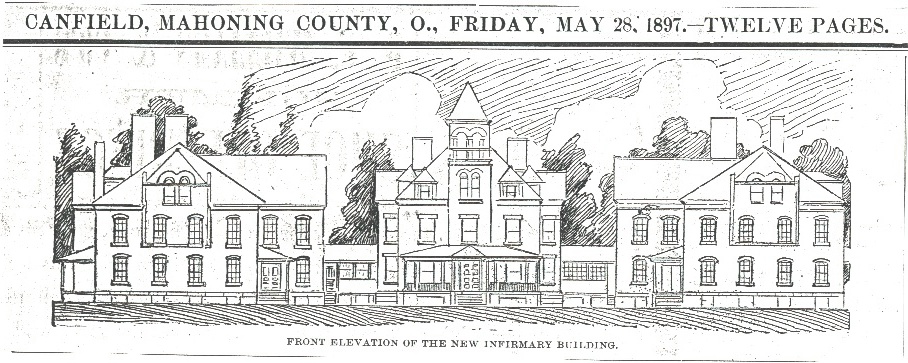
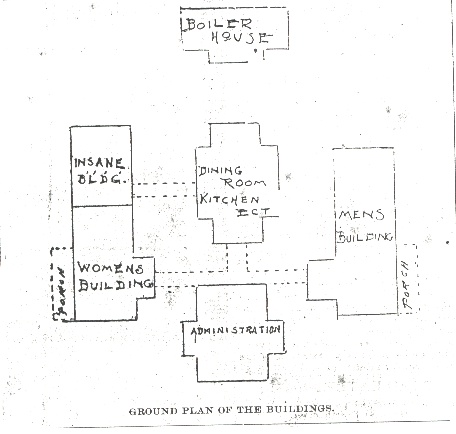
Mahoning Dispatch, Fri, 28 May 1897
“The New Infirmary – Will Be Constructed With Every Comfort for Inmates”
“Youngstown Telegram – The plans for the new county infirmary buildings are almost completed and will soon be ready for the bidders. The buildings, as shown in the architect’s drawings, present very plain exteriors, there being no attempt at ornamentation. Utility was the first consideration. The only relief from the severity of the design is the tower of the administration building. It serves to give prominence and singles out that structure from the others.
The buildings are five in number. The administration, women’s and insane (in one), men’s building, dining room, kitchen and laundry building and the boiler house. They are connected by covered passages which will be enclosed with glass in winter.
The administration building is 70 feet by 43 feet wide. The first floor contains the public reception room, office, dispensary, private sitting room, dining room kitchen, pantry and storeroom for the superintendent. On the second floor are the bed rooms of the superintendent and his family, those of the domestics in the superintendent’s service, bathrooms, etc.
The first floor of the woman’s building is divided into day rooms, dormitories and the insane department for men and women. The insane department, though a part of the woman’s building, is separated from it by a thick wall. It is almost the same as a separate structure. The state has promised to take the dangerous and violently insane patients from the county almshouses, and when that is done this department of the woman’s building will be divided into apartments for a certain class of inmates, such as husband and wife, mother and child, etc.
The first floor of the insane department is divided into day rooms, dining rooms, strong rooms and storerooms; the second floor into dormitories, attendants’ rooms and hospital rooms for the women patients. The size of the entire building is about 170 feet by 48 feet. The building will accommodate about 120 inmates in all. The insane department contains accommodations for 50 patients. The men’s building is similar in its departments to the woman’s building with the exception of the insane department. It is 146 feet long by 48 feet wide. The dining room is 100 feet long by 60 feet in width. It will accommodate about 160.
The central building contains the dining room, kitchen and laundry. The basement, which is high, is divided into laundry and drying rooms, bake rooms and storerooms. The first floor contains the general dining rooms, one for men with accommodations for 160, and one for women with accommodations for 70. The general kitchen, pantry and serving rooms are located on this floor. On the second floor there is a large dormitory and a chapel. All of the buildings are amply provided with lavatories and closets. The direct-indirect system of steam heating will be used and the most modern system of ventilation will be adopted. Electric lighting will be introduced throughout. As yet the material to be used in construction has not been decided upon. Bids for both ordinary and fire proof construction will be received.”
1898 New Infirmary Opened
Mahoning Dispatch, Fri, 23 Sep 1898
“County Infirmary Opened”
“The new infirmary buildings, in process of construction for more than a year, were completed last week. The institution is a model one and has ample accommodations for 500 inmates. On Wednesday and Thursday the buildings were open for inspection and many residents of the county took advantage of the opportunity to visit the most complete infirmary in the state. J.P. Byers, secretary of the board of state charities, wrote the following letter regarding the institution to the president of the board of county commissioners:
Columbus, O. – James S. Price, President Board of County Commissioners of Mahoning County, Youngstown, O.:
‘Dear Sir: – My recent inspection of the new infirmary buildings of your county gave me the greatest satisfaction. The plans and general arrangement I was somewhat familiar with, having had occasion to go over them carefully with your board and the architects. You know already the opinion of myself and this board as regards to the general plan. It was by far the most satisfactory set of infirmary plans ever submitted to this office for approval. I think you are to be further congratulated on the character of the work and materials used in the construction. I believe that your board has done well in requiring first-class materials and workmanship. Cheap buildings are usually expensive in the end. The Mahoning county infirmary has been built to stay and, if properly cared for, will require little outlay for repairs or improvements for many years to come. It will be a source of satisfaction here, as well as to Mahoning county, to know that we have in your county a model county infirmary.
With kindest regards, I am Yours very truly, Joseph P. Byers.’”
1901 Train Wreck Results in a Death
Mahoning Dispatch, Fri, 11 Jan 1901
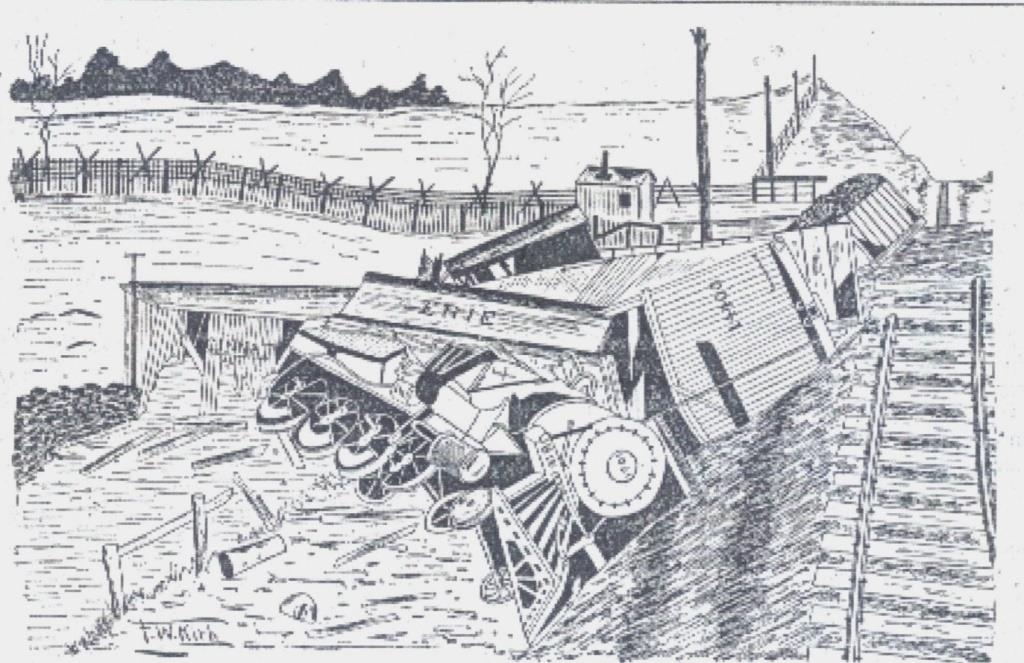
Infirmary Crossing Wreck
Caption: “The above sketch was made by the Dispatch artist after the locomotive had been turned from its right to left side so that the body of Engineer Frack could be removed.”
Mahoning Dispatch, Fri, 11 Jan 1901
“Death In A Wreck”
“At the Infirmary Crossing on the Niles and Lisbon Railroad Wednesday Evening”
“Fireman William Clem and Frank Brooks – Terribly Scalded by Escaping Steam –
Property Loss is Very Large.”
“Probably the worst freight wreck in the history of the Niles & Lisbon railroad occurred at the infirmary crossing, 1 ½ miles northwest of Canfield, Wednesday evening about 4:30 o’clock.
Engineer Charles Frack of Youngstown was instantly killed and Fireman William Clem of Brier Hill was terribly scalded as was Frank Brooks of Greenford. Head brakeman Garfield Powers of Girard was considerably cut and bruised and slightly scalded.
The accident was caused by running into several large sticks of ship timber being hauled to the railroad for shipment by Messrs Yager and Greenawalt. While the timber was being drawn across the track a chain broke. When the second attempt was made to move the load another chain snapped. It was at that moment that the men saw what is known as the Niles and Leetonia coal train come rushing down the heavy grade. Mr. Greenawalt ran up the track to flag the train but his warning came too late. The locomotive, No. 1031, a monster of the Wootten type, was running backwards, and the tender struck the obstruction with terrific force, stringing the timber along the track. The engine left the rails a few yards north of the crossing and ran 20 rods on the ties when it plunged down an embankment turning almost completely around and falling over on its side. Then came two box cars which plowed deep furrows in a field on the infirmary farm. Next to the locomotive was a box car loaded with fire clay and behind it three steel cars loaded with coal. These formed a half circle on the track. Behind them was a telescoped box car. Several other cars were broken down.”
Historical Overview of Infirmary Written in 1907
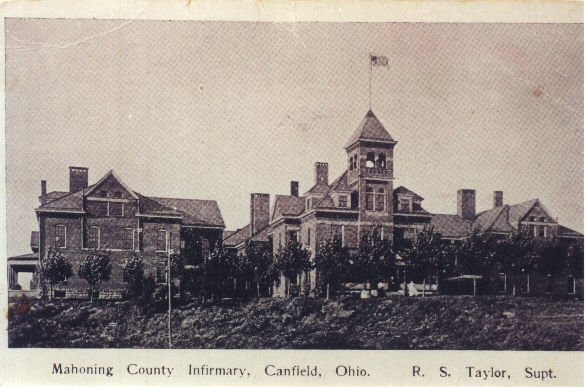
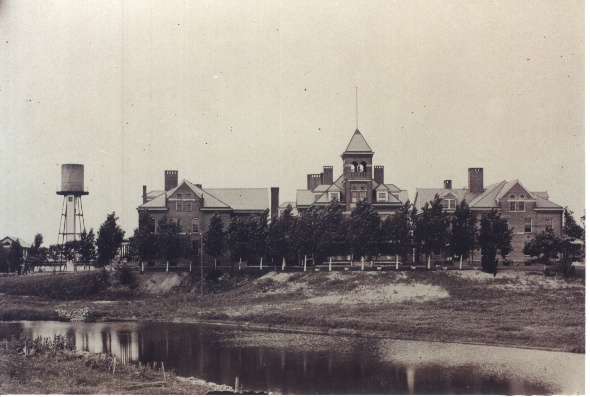
20th Century History of Youngstown and Mahoning County, Ohio
And Representative Citizens
Edited and compiled by Gen. Thomas W. Sanderson, 1907
Chapter XXVI, “Public Institutions” excerpt from pages 399-401
“The Mahoning County Infirmary”
“The Mahoning County Infirmary is situated about two mile north by west of the village of Canfield in the township in that name. Perhaps nothing shows more clearly the degree of progress made by the present generation over those which have immediately preceded it, than by a comparison of present day methods in caring for the poor and infirm with those in vogue in this section less than a century ago. Of the latter the reader may gain some idea from an entry in the Coitsville township records, Book No. 1 Page 19
‘Coitsville, January 1, 1810’
‘Whersas, information hath been given us that there is a certain Elizabeth Eward, came into our town, who is likely to become a town charge, we, therefore, according to law, command you James Mariner, Constable of Coitsville Township, to warn said Elizabeth Eward to depart said township instantly, without putting the town to any further trouble. And you are to return, etc., etc.
Signed, William Huston, James Bradford, Overseers of the Poor.’
The modern way of dealing with such unfortunates is well exemplified in the following sketch.
The Mahoning County Infirmary was founded within two or three years after the organization of the county. Additions were made from time to time until there were several buildings, certain quarters being reserved for insane patients, who are now cared for according to law in state institutions. On Saturday night February 20, 1897, the infirmary was totally destroyed by fire, with the loss, however, of but one life – that of an insane patient who rushed back into the burning building after having been rescued from it.
The superintendent at that time was Mr. James Dickson. There were 235 inmates of whom forty-five were insane. That all were rescued, with the exception of the unfortunate man above mentioned, was chiefly owing to the herculean exertions of Mr. Dickson, and the six or seven attendants, who were assisted by some of the inmates. After the fire the Park hotel was rented for a while as a temporary infirmary, the insane patients being provided with quarters in the county jail.
The present infirmary buildings were erected in the same year, from plans by Messers. Owsley & Boucherie, of Youngstown, architects, and at a cost of about $140,000. They consist of four large buildings, a front and rear building with two wings – built of brick with stone foundations, and connected by two glass-lighted corridors crossing each other in the center at right angles. The front, or administration building, which is the smallest, measuring 40×70 feet, faces south and is occupied by the superintendent, with his family and assistants; it also contains the reception room for visitors. In the rear or main building, which measures 107×67 feet, is the large dining room, where the inmates take their meals together, separate tables being reserved for the women. It also contains the kitchen and laundry, the former, a capacious room, being provided with a large Burton range, several large potato steamers in which three bushels of potatoes are cooked for each meal; also coffee and tea urns, and other kitchen utensils all of large capacity. Bread is baked three times a week, the bake-house containing a large mixer of two-barrel capacity, about one and a third barrels of flour being used at each baking. The oven holds eighty loaves, each from three to four times the size of an ordinary ten cent loaf. Close to the kitchen, on the other side, is the milk cellar.
The wash room contains a large steam washing machine and a centrifugal wringer. Two other rooms are connected with this department, one containing a large steam mangle and the other being fitted up as a drying-room. A large room on the second floor of the main building was designed as a chapel, but is used only occasionally, religious services being held but at irregular intervals, there being no chaplain attached to the institution.
The inmates occupy the two wings, the male inmates in the east, and females in the west wing. These buildings measure respectively 146×48 feet and 173×48 feet. Each wing contains two large, and a number of small bedrooms, the latter being reserved in general for the aged or invalids, or those who for any reason require separate attention. There are accommodations in the institution for 350 inmates, though at the present time (March 1, 1907) there are but 185, of whom about thirty are women.
In both the men’s and women’s departments there are rooms devoted to hospital purposes, where patients too ill to sit up are cared for and given medical attendance. There are also rooms in which a few feeble-minded people receive special care and treatment.
In the rear of the main building are the engine and dynamo rooms, the former fitted up with a 36-horse power Westinghouse electric engine, and three Babcock boilers erected by the Stambaugh-Thompson Company. This engine and the dynamo are soon to be replaced by a 55-horse power Russell engine, of Massillon, Ohio manufacture, having direct connection with a K.W. compound electric generator of 540-light-power. A small building back of the engine room is used as a machine shop.
Among the numerous smaller buildings forming a part of the institution are an ice-house, with a capacity of 200 tons, a soap factory, slaughter house, chicken house, turkey house, and cow shed. The kitchens, dairy, wash room, and other working rooms are laid with cement floors.
The land forming the estate consists of 210 acres on which are raised practically everything required for the consumption of the inmates and attendants. Last year the farm produced 180 bushels of wheat, 1,135 bushels of oats, 1,400 bushels of ears of corn, and 2,200 bushels of potatoes. Seventy-five tons of hay were also cut, being required for the live stock on the estate. Of the latter there are at present some twenty-five cattle, besides a goodly number of hogs and chickens, with a few turkeys. In the dairy were made last January 300 pounds excellent butter.
In addition to the farm there is a good sized garden, tended mainly by some of the inmates. In it were raised last year 5,000 heads of cabbage, 500 bushels of potatoes, 100 bushels of turnips, 20 bushels of onions, 75 bushels of beets, 25 bushels of grapes, and 500 bushels of apples.
The present superintendent, who assumed charge of the institution about a year ago, is Mr. Robert S. Taylor; he is ably assisted by his wife, who fills the post of matron, and by seven or eight employees. Visitors are admitted to the infirmary on Thursdays and Fridays.
With one or two exceptions, all the inmates are free patients no case being admitted until it has been passed upon by the board of directors, the members of which are elected every two years. This board, which visits the infirmary on the first and third Fridays of each month, consists at present of J. K Weir, Thomas Prosser and George Gordon.”
1907 Administrative Trouble at the Infirmary
Mahoning Dispatch, Fri, 17 May 1907
“Youngstown Telegram of Saturday: Confirmation of the worst rumors which have been coming concerning affairs at the Mahoning county infirmary at Canfield, has been made by the grand jury which adjourned at 4:15 Friday afternoon. The jury finds that there have been gross abuses, cruelty and mismanagement; that the place is infested with vermin, in spite of the fact that it was recently built; that inmates who have died have been buried without ceremony, and, finally, that in several cases inmates have been so treated that death has been hastened. W. R. Graham, prosecuting attorney, has announced that he will make no investigation of the charges contained in the report of the grand jury against the manner in which the county infirmary has been conducted. He said that the investigation, if made will be made by the infirmary directors.
Director Wier’s Statement
‘I have been asked to make a statement of conditions at the Canfield infirmary but delayed doing so in hope that the cause or causes of the difficulty there might first be removed. I believe in the main that conditions at the institution now are nearer what they should be than they have been any time since I ordered and carried out an investigation the first part of March, this year. The public will probably learn with surprise that an investigation of affairs at the institution was carried out, but such was the case and at my request. Complaints commenced to come in early last fall. Nearly every employee on the place had a grievance which was brought to me. They complained of a lack of harmony in the organization and of being indifferently treated by the superintendent, Mr. Taylor. Male inmates complained to me of carelessness in care of their quarters which they said were infested with vermin. This complaint together with the apparent lack of management led me to demand a prompt investigation.
The other two members of the board on having the situation presented to them by me, agreed to a hearing of the reports and an investigation was held March 8 at the infirmary. At the investigation were the directors, the superintendent, the matron employees and one inmate Bartholomew (‘Batty’) Brown. They were all called in together. Each and every one there questioned testified to a lack of harmony in the organization, that male inmates had become infested with vermin, that in some instances the sick had been neglected in the way of being given proper care by attendants. I found the story of a man fastened to his bed to be correct. He was in a dying condition at the time and the fastenings were used in order to make it easier to handle the patient who was partly of unsound mind. I severely censured Mr. Taylor for allowing this to occur and think this alone warrants his dismissal.
It is the custom to place the sick and infirm under the charge of trusties or the stronger of the inmates, who in turn act under the leadership of one paid trusty or attendant. He is in charge of the work of that nature. He sees or should see, that it is done. He is held responsible by the superintendent and it is the business of the superintendent to see that the ministrations to the sick are properly carried out. This I found was not done. There was complaint of a scarcity of delicacies served the invalids after the fixed custom. We found the more substantial food well served, clean and abundant. There was a complaint of a lack of ventilation which was obviated by the opening up of fireplace. There was one complaint of lack of warm clothing by an inmate whose duties took him outside to work. The board remedied these evils as promptly as possible. Disinfectants were ordered. I am positive they scrubbed and cleaned out. Those affected by vermin wore properly cared for. Delicacies were ordered. Everything, in fact, was done to put the institution in first-class shape.
All the charges of incompetency on the part of the superintendent were proved to our satisfaction and the cause would have been promptly removed had it been in my power to do so. It takes two votes to dismiss a superintendent. Being satisfied that I could do nothing alone I did the next best thing. I had the entire institution cleaned and cared for and tried to effect a harmony and better understanding among the attaches. Mr. Taylor was given a severe reprimand. I told him that any further neglect on the part of him or any one there would mean an immediate dismissal. That was as far as I could go under the circumstances. I stood ready then and I stand ready now to carry out the instructions of the grand jury and the prosecuting attorney to remove Mr. Taylor.
The published reports of the number of deaths on a perusal of the records will be found grossly exaggerated. Many in the last stages of disease and past all earthly aid are turned over to the infirmary. These people and the aged, crippled and infirm are what compose the population at the institution and naturally the mortality is greater among such a class. I offer this explanation, not as a defense but because I believe the public is entitled to know the inside history and the entire truth about the case. The facts above stated are precisely as I have testified although given in brief. It was my purpose on having this trouble brought to my attention to straighten it out as promptly as possible. I believe that under the circumstances I did everything that could be done. All of the complaints heard by the grand jury were those which had previously been heard by the board and I am confident that the truth was told. I testified myself to the grand jury all facts above given and also to complete overhauling of the infirmary since such conditions were in existence.
I am positive that the work at the institution is now progressing in a humane, sanitary and businesslike way. The investigation in March was thorough and resulted in much good. I am however, ready to continue along the line of weeding out of every incompetent as asked by the grand jury. John K. Wier.’
Matron’s Statement
‘Editor Dispatch: – I am surprised at the most ridiculous assertions made by J. K. Wier against us in regard to the management of the infirmary. The institution is in no better condition today than it was before March 8, 1907, with the exception of the usual spring cleaning. But one of the greatest grievances I have to encounter is that I am strictly forbidden by Mr. Wier to use any patent medicines or ointments of any descriptions, which if allowed I could many times please those old people to a great extent and with far better results than with whisky. Furthermore, Mr. Wier has not been through the institution three times during our administration and he really does not know the true conditions of the sick here today, for the meetings here he is always in a great hurry to get away, for it seems as though he is more interested in sports than in the condition of the institution. Mr. Wier’s theories might be very well for running a rolling mill, but I don’t approve of them for running an institution to care for the poor. Mrs. R. S. Taylor’
The Birmingham brothers, Youngstown painters, now figure in the infirmary trouble. Mr. and Mrs. Taylor charge that an unsatisfactory job of painting was done at the infirmary by the Birminghams and because they reported the matter to the infirmary directors ‘Chip’ Birmingham, who assumes to cut some considerable figure in politics, threatened to have the Taylors removed, even going so far as to say who would temporarily succeed them. It is also charged that the painters while boarding at the infirmary spent considerable time painting political banners which were taken to Youngstown. Mr. and Mrs. Taylor are firm in the belief that the unsatisfactory job of painting referred to is responsible for starting the stories that startled the county. A meeting of the county commissioners will be held at the infirmary Friday when conditions will probably be looked into.”
1908 Nelson Shaffer, Infirmary Director Nominee
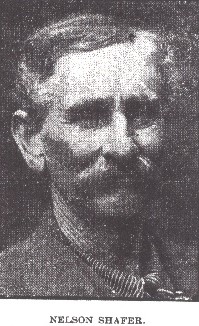 Mahoning Dispatch, Fri, 7 Feb 1908
Mahoning Dispatch, Fri, 7 Feb 1908
“Nelson Shaffer”
“A Successful Farmer of Canfield Township, is Making a Hard Fight for Nomination of Infirmary Director”
“Nelson Shafer of Canfield township announces his candidacy for infirmary director at the republican primaries Feb. 11. Mr. Shafer was born and raised in Mahoning county and is one of the prominent farmers of the county. At the age of 16 he enlisted in the army and served his country for some years. He has never before been a candidate for public office and now announces himself a candidate only through the solicitations of his numerous friends who realize that the office demands one of stainless character and who has a knowledge of farm life coupled with business integrity and ability. Canfield township has not been represented in any county office for fifteen years and the people of the township think it no more than just and equitable that they now have a voice in our local government. Mr. Shafer is not and will not be allied to any political boss or faction and if chosen by the people he will perform the duties of his office without fear or favor.”
Obituary for Nelson Shaffer (Husband of Mary Magdalena Neff)
Mahoning Dispatch, Fri, 10 Sep 1915
“Nelson Shafer died last Sunday morning in the Massillon state hospital where he had been receiving treatment for several months. The deceased for many years resided on a farm in the northern part of this township. When a lad of only 16 years he entered the service of his country, serving with distinction in the civil war. He was the youngest man in his regiment and among the youngest who shouldered arms in the Union army. (Co E 12th Ohio Cavalry)
Mr. Shafer was 68 years of age. Two years ago last January his son and a granddaughter perished in a fire which destroyed their house on an adjoining farm and from that time his mind began to weaken and he never again was himself. He is survived by his wife and two daughters, Mrs. Gardner of this township and Mrs. B. K. DeCamp of Youngstown. Funeral services were held Tuesday afternoon and interment was made in Zion cemetery, one mile north of the village.”
1909 Mahoning County Infirmary Fire – Total Loss – Four Deaths
Mahoning Dispatch, Fri, 29 Jan 1909
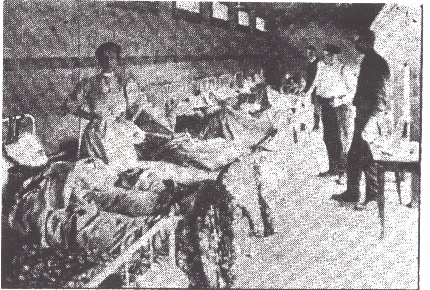
“Scene in the new tuberculosis hospital where the men burned in the fire were temporarily placed after receiving medical attention.”
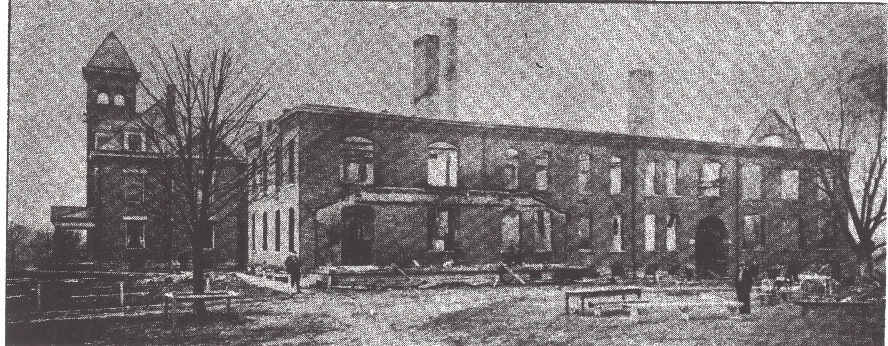
“Picture of Men’s Building at the County Infirmary Destroyed by Fire January 21.
(Courtesy of the Youngstown Telegram.)”
Mahoning Dispatch, Fri, 29 Jan 1909
“Echoes From Infirmary Fire”
“Two deaths have resulted from the county infirmary fire of last Thursday. John Davies, 65 years old and an inmate of the institution since Oct. 19, 1907, died Saturday evening. His remains were taken Sunday to Palmyra, where he has two nephews, for burial. Davies returned to the building to secure $3 he had left in his haste to escape and sustained fatal burns by inhaling the flames. Harry Hird, single and 60 years old, who went to the infirmary from Youngstown Nov. 14, 1908, died Wednesday night from the effects of his burns. He has no known relatives and his remains will be buried in the infirmary cemetery. Of the other men burned all will recover with the possible exception of Phillip Eckhart and Arthur Evans. Their condition shows no improvement and it is feared they cannot recover.
Nothing more definite is known as to the origin of the blaze than what was given in the Dispatch report last week.
The male inmates are now quartered in the woman’s building, the women about 35 in number, being given three large rooms. Of course the building is somewhat crowded, but not to the extent of making it uncomfortable for the unfortunates.
Insurance adjusters were at the infirmary Thursday to fix the loss. No work has been done on the ruins. It is possible that John Minck, aged 60, of Petersburg may have been cremated. He is missing, and as he was at the infirmary for dinner the day of the fire fears are entertained for his safety. If he perished his bones will be found when the debris is removed from the cellar. All tuberculosis patients have been placed in the new hospital.
The prompt action of the county commissioners and infirmary directors in securing new beds, bedding and other necessaries saved the inmates much inconvenience and they had everything possible done to alleviate the suffering of the men who received burns. A fire engine, other equipment and firemen were brought from Youngstown on a special train Thursday evening and water was poured into the burned structure until 3 o’clock Friday morning when only smoking embers remained.
The brick walls of the burned building have been inspected by an expert and found to be in such good condition that they can be used for reconstruction. This will save the county many thousands of dollars. Plans are being considered by the county commissioners for immediately rebuilding the structure which will be fireproofed. No figures are given out as to the probable cost but perhaps $50,000 will not be far out of the way.
The insurance on the burned building was $25,000 and on contents $2,000.
Fire escapes will be placed on the women’s building so that the men quartered temporarily on the second and third floors may have easy means of getting out in a hurry should occasion require.”

“Two Men Were Cremated In the Infirmary Fire – Remains of the Unfortunates, John W. Minck and Daniel S. Murphy – Recovered Wednesday Evening.”
“Wednesday morning the insurance was adjusted on the burned men’s department of the county infirmary and work started at once to clean up the debris. All day men delved in the ruins and late in the afternoon the bodies of two men, who had been missing since the fire on Jan. 21, were recovered. They were those of John Minck and Daniel Murphy. The former was 77 years old and entered the infirmary from New Springfield Oct. 11, 1905. He was a native of Maryland and had not long resided in this county. He had papers showing that he was a member of a Masonic lodge in his native state. The latter was 68 years old and was born in Wales. He went to the infirmary from Youngstown Jan. 4, 1909. So far as known neither of the men had relatives, no inquiries having been received concerning them. The bodies were so badly burned as to be unrecognizable. One was found on the small unburned portion of the floor in the second story and the other in the cellar under the men’s sitting room. Funeral services conducted by Rev. W. S. Rowe were held at 1:30 Thursday afternoon. Burial in the infirmary cemetery. Two other deaths resulting from the fire, already reported in these columns were John Davies and Harry Hird. Two other men, Dennis Mahoney and Arthur Evans, it is feared may not recover from their burns. All the other sufferers are on the road to recovery.”
1919 Dr. Lewis Deweese Coy Ends His Association as Infirmary Doctor
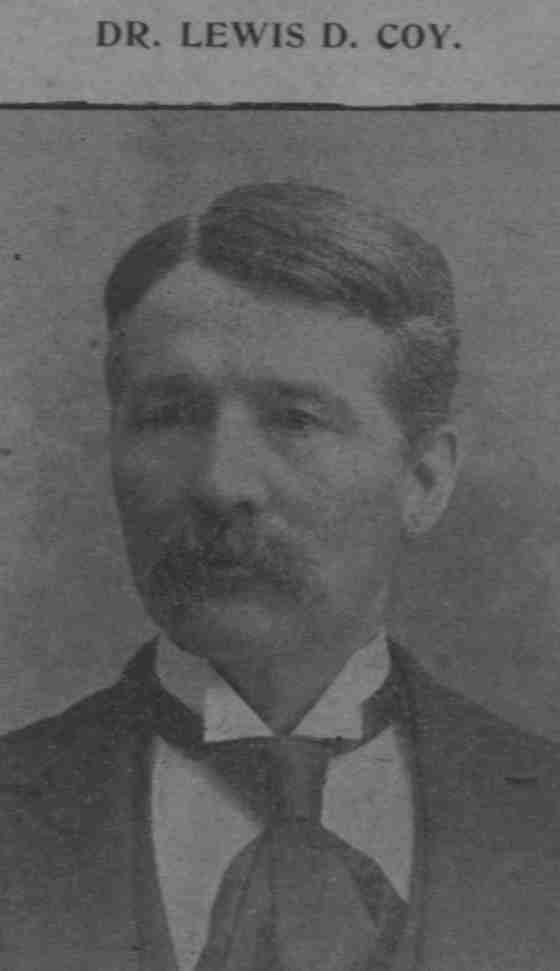
A Register Mahoning County Infirmary, Canfield, Ohio is in the possession of a local historian. The Register is dated from September 1899 to March 6, 1930. It is ¾ full of names and residences of individuals who appear to have been visitors at the Infirmary. It has not been transcribed. One of the last entries of Dr. L.D. Coy states that on November 21, 1919, he had served the Infirmary for thirty years and had performed his last duty on that date.

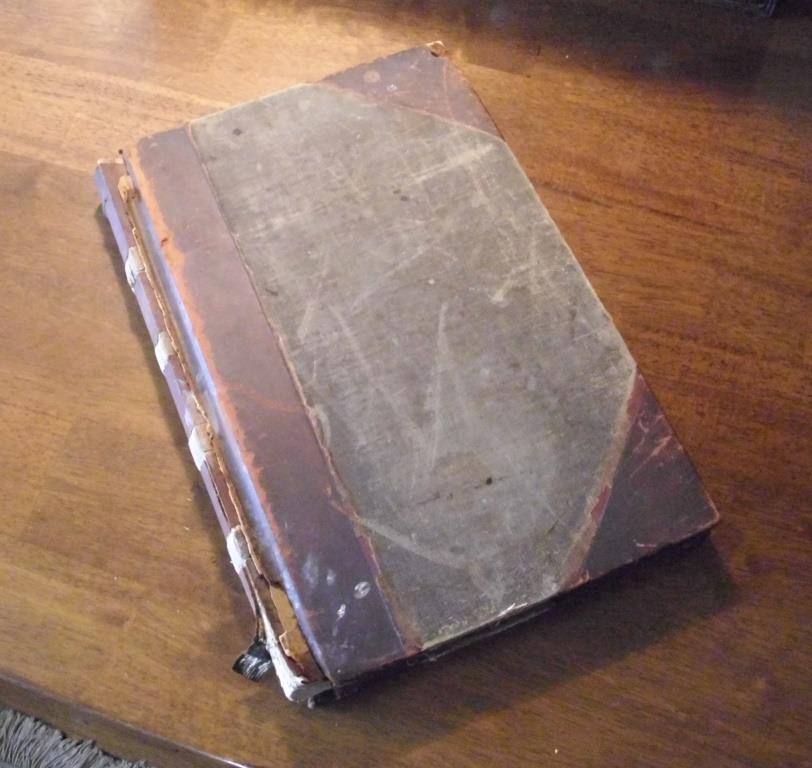
Visitors’ Register Mahoning County Infirmary, Canfield, Ohio, 1899-1930
This ledger is 16 1/4 inches long x 10 3/4 inches wide and it is 1 ½ inch thick.
Depression Years – A Sign of the Times
Mahoning Dispatch, Fri, 13 Apr 1933
“Three men scantily clad, rain soaked and nearly bare foot who were unable to gain lodging at the county infirmary Wednesday night because of its crowded condition were provided with shelter and warmth in town hall by township clerk W. J. Dickson. And he did not turn them away Thursday morning without breakfast. The men told stories of much hard luck, especially the past year, and were profuse in their thanks to Mr. Dickson for the assistance given them.”
Bubbles, a Familiar Infirmary Figure
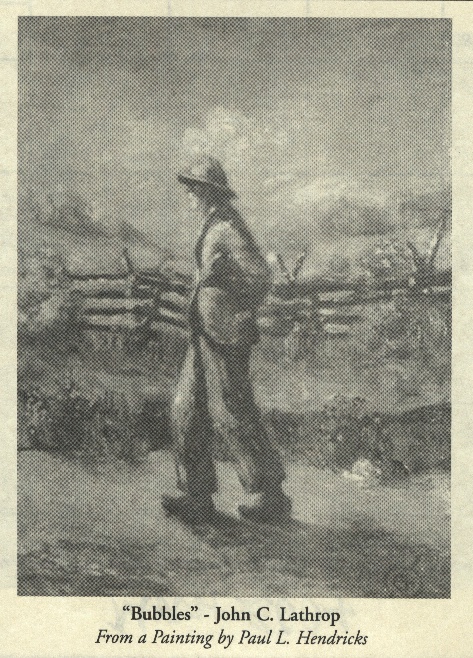 John C. Lathrop “Bubbles”
John C. Lathrop “Bubbles”
B. 28 Apr 1875 in Trumbull Co.
D. 25 Apr 1949 in Canfield Twp., Mahoning Co. OH at 73y 11m 27d
Burial – Apr 1949 in Mt. Hope Park Cemetery, Scienceville, Mahoning Co. OH
Mahoning Dispatch, Fri, 29 Apr 1949
“Bubbles” Will Roam No More”
“John Lathrop, 73, died Monday morning in the Mahoning County Home, where he was taken last January. Known as “Bubbles” to hundreds in the locality, he had roamed over Canfield and other nearby townships for over forty years, living on “handouts” given him by sympathetic residents and usually spent his nights wherever darkness overtook him, most frequently in farm barns. Although never on especially friendly terms with manual labor, he did help on area farms at intervals in past years. Never fastidious about his personal looks, he usually wore all the clothing he owned, giving him a Falstaffian appearance. As the years passed he became more and more careless in his habits, and in recent years had omitted his “Spring” shave, wearing a full beard the year ‘round. Mr. Lathrop was born in Trumbull county, April 28, 1875, a son of John and Margaret Lathrop. He is reported to have had a college education, later suffering a nervous breakdown, from which he never recovered. An eager reader, he constantly sought for newspapers and magazines, removing clippings which especially interested him. Two years ago he froze his feet and otherwise suffered from exposure, which broke down his rugged constitution. Still making his rounds, he was taken ill in January and was placed in the County Home, an institution he previously abhorred. No known relatives survive. Burial was made in the Scienceville cemetery where other members of the family are buried.”
1959 Selling Land
Youngstown Vindicator, 9 Nov 1959, p.1 c.5
“Will Sell County Home Land – In Step Toward New Unit”
“Mahoning County commissioners today passed a resolution to sell 280 acres of County Home land as one of the steps toward beginning the new home approved by the voters Nov. 3. Other steps taken on the County Home today included resolutions thanking Mrs. John W. Ford and Atty. James E. Bennett Sr. as co-chairman of a citizen’s committee backing passage of the County Home levy. The commissioners told these two civic leaders and members of their committee, ‘We are appreciative of your work and grateful for the results.’ The commissioners also will ask the state fire marshal for another extension of time on the present condemned County Home since the levy for the new one passed successfully. The present extension was supposed to last until election results were known.
Grateful for Grant
Dr. Margaret Doubois, head of the state board of health, division of hospital facilities, also got the commissioner’s thanks for getting the county a $150,000 grant for hospital facilities at the new home.
In selling the old home land in Herbert Road, the commissioners will reserve the quarter-acre of land on which the home stands until the new institution is ready in about two years. Originally there were 325 acres but 30 acres was sold to the Canfield Board of Education for school purposes and 15 acres to the village of Canfield for a sewage plant. The commissioners hope to realize about $300,000 from the sale of the land.”
1962 Preparing for Departure
Youngstown Vindicator, 9 Dec 1962, p.E1 c.7; and cont. by Jane Lamb
“Hate to Leave Thursday” “Some Will Miss Old County Home”
“Veteran Residents Used to ‘Shoe,’ Fear New One May ‘Pinch’
Even a good wind blows somebody ill. Moving to the glamorous new county home Thursday is a far from happy prospect for several residents of the decaying building on Herbert Road.
The old place is home
Residents have had a relaxed schedule, fairly free run of its dilapidated quarters and environs, and it is comfortable in the manner of a worn-out shoe. Many an old-time is afraid that the new one will pinch. ‘It will be miserable,’ predicted Jim Shaw as he and several others as they expressed their apprehensions.
Asked to Discard Small Possessions
During the immediate period before the move, residents have been asked to discard many of their small possessions, a remaining link with the past and their sense of identity. In the fine new structure things will have to be in place, out of sight, hung no more over bedposts, tucked under beds or in out-of-the way corners. The new building will be on display. Actually the architects have attempted to provide more space. In place of the present footlocker, each person will have a wardrobe, drawer and mirror, a desk with drawer, for toilet articles. In the nursing section there also will be a nightstand with drawer and cabinet. The discarding notice is what causes concern. Some persons have a fairly large accumulation of things. Word that the men should take the equivalent of only two suits disturbs Alex Harris who has a number of good garments. He likes to change and to be clean. Getting rid of some of his clothing presents difficult and painful decisions. ‘It is like taking your privileges away from you,’ he says. ‘We’ve got to go over there naked just like we came into the world,’ Shaw protests.
‘Pillow Speakers’ Replace Radios
Individual radios are on the cast out list, too. At the new home there will be ‘pillow speakers’ so that others need not be disturbed. Receivers will hang on beds like a radio or may be put in pillows for listening. But residents believe that if individual radios are not allowed, free choice of stations will be a thing of the past. Provisions in the new building are for a central control with five radio stations to select from and a sixth circuit for any religious service that may be going on in the building. But Shaw will miss his precious large radio with its record accommodation and his record collection. Other rumors persist that there will be no smoking or tobacco chewing at the new home. ‘If this is true, it will be ‘hell’,’ just like a prison’, explodes one disconsolate oldster. Certainly tobacco chewers will have to be more careful of their aim but administrators know of no non-smoking orders. The building has fire resistant construction throughout and there is extra provision for ventilation.
Angler Will Miss Old Fishing Hole
‘There will be no fishing pond,’ complains Bert Sutheran, ‘We won’t be allowed in the recreations rooms as long as we want,’ another said suspiciously. Several others are taking a wait-and-see attitude. Nobody really knows what to believe among all the unofficial reports circulating. ‘Some say one thing, some say another,’ says John Poskar, an 11-year resident. Elmer Ohl who has been at the home for four years thinks it will be ‘okay’ but reserves judgment.
Hopes New Activities Include His Hobbies
Residents have been hearing there will be things to do outside of the usual routines of sleeping and watching television. ‘I don’t know,’ says Carl Jacobson, wheel chair patient who has been at the home 16 years. If there are any planned activities he is hoping they will include stamp and coin collecting and maybe playing a guitar. Jacobson’s collection includes a Greek coin 1,500 years old and an Indian coin 663 years old. He played a guitar many years ago and believes he still can do it. Ohl is hoping for a pool table but planners have made no provision for one. Important improvements include occupational and physical therapy. An occupational and a physical therapist will be added to the staff and areas for these programs have been set up and equipped with basic essentials. The physical therapy section is especially well equipped for an extensive program. It includes a full sized whirlpool as well as two small ones that will benefit partially paralyzed patients like Pearl Wigton. There also will be diathermy, traction units, walking bars, heat therapy and a good program for all kinds of exercise.
Continued: Many Old-Timers Will Miss Warmth of Old County Home
Shuffleboard, Games Will Be Provided
There also will be day rooms with fireplace for recreation and television. Outside there will be four shuffleboard courts, horseshoes and permanent benches. Other additions will be a barbershop, a beauty shop and a snack bar. Residents have not seen these things, however. They are concerned about room mates. Residents now live in large wards, but they will be assigned four to a room in the new home. Will they draw a group with whom they cannot get along? This is a current nagging question. ‘I just hope I don’t have to sleep with any drunkards,’ one, old-timer said apprehensively. The oldest resident of the county home, Mylo Bordini now some 88 years old, fixes the questioner with a penetrating gaze but refuses to discuss the matter except to say that he came originally from Serbia. He has been at the county home since 1914. A great walker Mylo sometimes travels from the home into downtown Youngstown and has earned a few simple extras by picking and selling fruit.
Some Are Eager To Make Change
But there is eager and happy anticipation, too. Lil Brenner, a resident of the home for some 31 to 34 years, exclaims she will be ‘glad to get out.’ Blanche Benson, a resident for only three months is looking forward to the ride. Confined by a broken hip, she says she would go tomorrow and looks forward to ‘the new.’ Others give firm assurance they will be ‘so-o-o glad’ when moving day comes. Other do not really care, just so long as their faithful nurses come, too. At the present time there are only six nurses and 10 aids for some 136 residents. Five who left this year have not yet been replaced, spokesmen say, but welfare officials expect that six to seven additional persons may be needed. At present two aids work in the wing with 55 men during the afternoon, and one is on duty at night. Another wing with 37 women has one aid, and a group of 17 who need extra care have an aid. Many more retarded and epileptic persons have been sent to the home from state hospitals in recent year, an observer says.
Same Personnel Will Make Up Staff
l.L. Feuer, Mahoning County Welfare director, reports that the new building will begin operating with the same personnel. The six or seven new ones who may be needed must be certified by civil service and in the meantime would have to be hired on a temporary basis. Examinations probably will be held during the first two weeks of January. The Civil Defense Office will assist with the moving of all residents Thursday. They will be transported by ambulance and buses with the expectation that everything will be finished by noon when the first meal will be served in the building.”
1962 Dilemma Over Next Step
Youngstown Vindicator, 11 Dec 1962, p. c.2; and cont. by William K. Gibson
“Old County Home’s Future Is Problem for Officials”
“Mahoning County Commissioners, happy over a new $2,160,000 county nursing home, to be occupied Thursday, are equally glum over what to do with the relic on Herbert Road. The old home, which has served as shelter for thousands of poor, needy and infirm since before the turn of the century, will be as deserted as a haunted house Thursday night. Its residents, staff and administrator will all be in the new, modern structure on Kirk road. Commission Chairman John Palermo says the old home should be boarded up, locked from the inside except for one door with a strong outside lock, and left to the elements, at least until it can be torn down or the whole property, land and house buildings sold. County Commissioner Thomas J. Carney believes a night watchman should guard against vandalism, or that the old brick structure should be razed. County Commissioner Edward J. Gilronan wants to get rid of the land and buildings as soon as possible. It is pretty well agreed that there isn’t too much worth salvaging outside of kitchen equipment which might be sold at auction. There is also the question of the superintendent’s handsome brick home, overlooking the little lake at the front of the property. It was built in the 1940’s after World War II and caused quite a stir because of its cost, $35,000. Commissioners favor renting the superintendent’s home unless a sale can be arranged. If they do rent it they will have to spend some money to install a heating unit because its heat is furnished now by connections with the main county home’s steam heating plant. To keep that large boiler going just to heat a nearby house would cost more than the house would bring in rent. Commissioners have tried to sell land at the old county home, but found few takers. Most want to break up the property and buy a small parcel here or a small parcel there for either industrial, commercial or residential use. The commissioners do not want to go into the real estate business and would like to get rid of the whole acreage, old barn-like institution and the superintendent’s house in one deal.”
Bids on Infirmary Property
Youngstown Vindicator, Sun, 19 June 2005 (For 19 June 1965)
“The Youngstown Development Co., 1445 Belmont Ave., is high bidder on the 313 acres of old Mahoning County Home property on Herbert Road with an offer of $2000, 0000 for the entire parcel.”
Youngstown Vindicator, 21 June 1965, p.1 c.5
“Bids Dropped For Site of County Home”
“County commissioners today threw out all three bids they received last week for the old Mahoning County Home property, two on technicalities and one because it was too low and contained too many conditions. The high bid of $200,000 by the Youngstown Development Co. was thrown out because it was not accompanied by a certified check, as required by law. Albee Homes, Inc., of Niles was second-high bidder with an offer of $186,661, but failed to put a signature on the bid. The third bid, that of an undisclosed Cleveland manufacturer made through Realtor Cliff Fisher, was turned down because it was too low. It was for $150,000 and contained several conditions objectionable to the commissioners such as getting a zone change for the property within a certain time limit. This is the third time that bids for the old county home have been turned down, and in all cases they have been refused because they have been so far below the $1,000 an acre commissioners hope to get for the 313-acre tract on Herbert Road.”
1968 Infirmary Gutted by Fire
Mahoning Dispatch, Fri, 26 Apr 1968
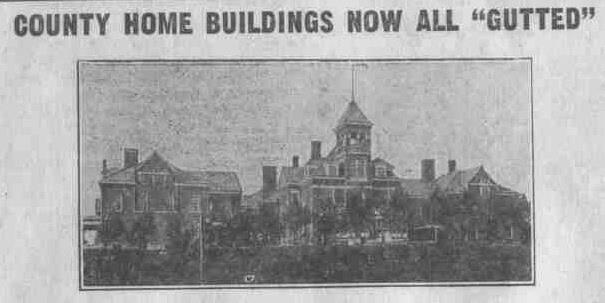 “For the ‘steenth time in recent months, arsonists went into action again last week, setting fires which completely gutted the main build at the abandoned Mahoning County Home on Herbert Road. Canfield firemen have been doing stand-by duty, and letting the numerous fires burn themselves out. This was the last building left standing on the farm, other buildings having been destroyed by vandals in recent months. The property now belongs to the never-approved Mahoning County Community College, under a contract which donated the county-owned property for educational purposes. This expires next September. County commissioners have frequently been urged to raise the old building as a safety measure, as children have found it an attractive place to play. Pictured above is the Mahoning County Infirmary shortly after it was completed in 1898, replacing the original building destroyed by fire in February 1897. Of the 240 inmates, only one died in that fire. In January 1909, the men’s wing of the building was gutted by fire, which started on the third floor. At that time, thirteen men of the total population of 225 in the institution suffered burns; four died.”
“For the ‘steenth time in recent months, arsonists went into action again last week, setting fires which completely gutted the main build at the abandoned Mahoning County Home on Herbert Road. Canfield firemen have been doing stand-by duty, and letting the numerous fires burn themselves out. This was the last building left standing on the farm, other buildings having been destroyed by vandals in recent months. The property now belongs to the never-approved Mahoning County Community College, under a contract which donated the county-owned property for educational purposes. This expires next September. County commissioners have frequently been urged to raise the old building as a safety measure, as children have found it an attractive place to play. Pictured above is the Mahoning County Infirmary shortly after it was completed in 1898, replacing the original building destroyed by fire in February 1897. Of the 240 inmates, only one died in that fire. In January 1909, the men’s wing of the building was gutted by fire, which started on the third floor. At that time, thirteen men of the total population of 225 in the institution suffered burns; four died.”
1968 Razing the Infirmary
Youngstown Vindicator, 9 Sep 1968, p.1 c.1
“Will Ask Bids For Razing of County Home”
“County commissioners will advertise the last of this month for bids to tear down the old county home in Herbert Road and restore it to agricultural land at a total estimated cost of $25,000. The engineer’s estimate would include tearing down all buildings, hauling away all debris, sealing off old sewer and water lines, hauling in agricultural land fill, and restoring the property to its natural state. The old home site has become an eyesore and a danger. In recent years there have been several fires, wholesale vandalism, and the place is a source of danger to trespassers. Technically the land now belongs to the Mahoning County.”
Canfield Courier, 17 Oct 1968

“Finally, after much dissent and controversy, the Old County Home is being razed by the Ohio Contracting Co. of 777 N. Meridian Rd., low bidder on the $16,000 job. The engineers had estimated cost of the demolition at $28,000. Eight other firms bid on the job, which includes tearing down all existing structures, filling with dirt, clearing all debris and restoring the property to agricultural land. There are approximately five buildings in all, and work is expected to be completed in three weeks. The County Home, vacant for many years, has been a constant problem to the fire department, as there have been numerous fires started, apparently by children playing with matches. The County Home was constructed about 1897, judging from a huge stone, weighing approximately 400 pounds inscribed ‘1897 A.D.’ The stone mysteriously disappeared after it was carefully removed.”
Selling the Land
Youngstown Vindicator, 4 Mar 1972, p.3 c.1
“$122,000 Bid On Home Land”
“The often advertised 81 acres of old Mahoning County Home property finally may be sold by county commissioners who Friday received two bids, the higher an offer of $122,000. Twice before the residential land just outside Canfield city limits, has been offered for sale by the county. Once the bids had to be rejected for a technical error in advertising. The next time the lone bid was thrown out by the county commissioners because the bid was so much below the $115,000 appraisal price. Friday it brought bids from Louis Lev & Son at $90,000 and from Atty. Regis Gilboy for $122,000. The commissioners will take the matter under advisement, but are likely to close the deal with official approval the first of next week. Atty. Gilboy was unable to be reached Friday afternoon, but it is believed he was acting as an agent.”
Youngstown Vindicator, 8 Mar 1972, p.6 c.3
“Mahoning County commissioners Tuesday sold 81 acres of county-owned land just north of Canfield Village to Atty. Regis Gilboy Tuesday (sic) on his high bid of $122,000. Atty. Gilboy is representing developers interested in the land for residential purposes. The land formerly belonged to the old county home. The commissioners have tried to sell the parcel several times. Atty. John Tumbri, a vice president of the First Federal Savings & Loan Association, was hired to clear the title.”
1989 Infirmary Cemetery Dilemma
Youngstown Vindicator, 23 July 1989, p.A1 c.3 by Karen Guy
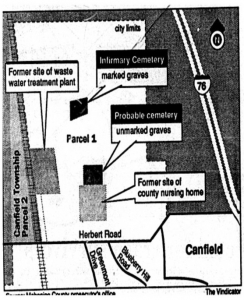 “Past and future of cemeteries pose mystery”
“Past and future of cemeteries pose mystery”
“Many may be buried in unmarked graves on old nursing home site sold for development”
“Before the era of Social Security, the poor, sick and aged relied on the kindness of families or strangers. In Mahoning County those who were indigent made their home in dark dormitories of the county infirmary in the rolling hills off Herbert Road. The land,
now overgrown with vegetation and dotted with gas wells, reached a milestone last week when it was sold to a private developer. But from 1897 through 1962, when it had fallen into what many community leaders considered shameful disrepair, hundreds stayed at the home at taxpayers’ expense.
Some who lived there were elderly immigrants who were unable to speak English. Others, termed ‘idiots’ just a few decades ago by professionals in the field, were considered insane or retarded. Some were just old and poor and alone. And when they died, many apparently were buried on infirmary grounds. Their bodies, as far as an assistant prosecutor assigned to handle the situation can tell, ended up in paupers’ graves there.
Some may be buried in an unmarked cemetery just north of where the main building stood, she said. A cemetery with small numbered markers and meager wire fence is further north. The new owner of the land, however says that those who know the area have told him that there is only the one cemetery – far north of the building site near a creek. And, he says, only those who died in the 1918 influenza epidemic were buried there. Assistant County Prosecutor Sharon Hackett, who is assigned to the civil division and helped with the sale of the 233 acres located in Canfield township and city, said that based on a few records she could find, corpses started being taken to funeral homes for burial elsewhere around the 1930’s.
No one has tended the area in many years. All signs of the infirmary and its agricultural out-buildings, along with a waste-water treatment plant, that used to be nearby, are gone, and the burial grounds have been reclaimed by the grass and trees of the countryside. The area is zoned for residential development, although there are several acres of unusable land with gas wells and easements for utility lines.
Commissioner Leonard Yurcho said construction of homes there will generate income tax for the city and real estate taxes for the schools. According to the informational packet provided to prospective bidders, it will be up to the new owner to decide whether to move the cemetery or cemeteries, whichever the case may be. Charlie Masters, treasurer of B.&J. Enterprises of Canfield which bought the land Thursday for $459,630 plus about $110,000 in back taxes, said the marked cemetery plot most likely will be enclosed by fences. ‘Our intention is to leave them there,’ he said, ‘I’m not into digging, people up.’
Atty. Hackett said state law on care for government cemeteries and disinterment in general contains ‘a major gap.’ ‘We’re in uncharted waters,’ she said after studying the Ohio Revised Code. Laws governing county cemeteries were repealed long ago. Statutes on township and municipal cemeteries do not apply because the area only recently was annexed into the city, Atty. Hackett said. She noted, however, that disinterment traditionally involves exhaustive attempts to notify kin of the deceased. The assistant prosecutor likened the sale of the county land to the sale of a farm on which a family had been buried long ago. What bothers her is that she has been unable to ascertain exactly which infirmary inhabitants are buried there and which claimed by long-lost relatives, are not. County records that Atty. Hackett and others have viewed so far do not address the specifics on burial. They just list the deaths. And there are hundreds of them, she estimated, shaking her head. ‘This just emphasizes the importance of record-keeping,’ she said. ‘People probably thought, ‘What are we ever going to need these records for?’”
1998 a Grave Situation
Youngstown Vindicator, 6 Mar 1998, p.B1 c.1 by Roger G. Smith
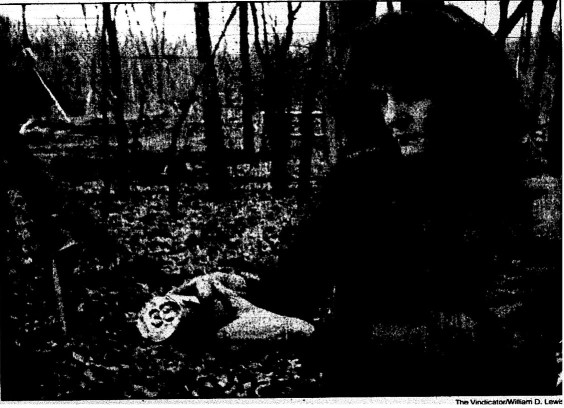
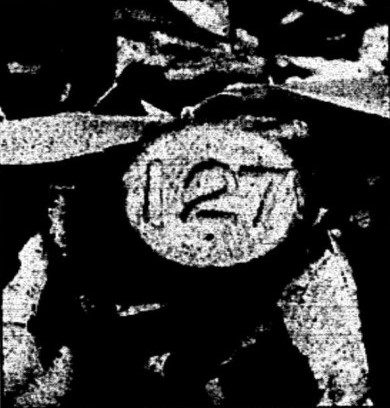
“Disturbing Find: A dispute, with a developer over a buffer zone became personal for Sally Pallante of Canfield when she discovered grave markers at a nearby cemetery had been broken and scattered around. The simple numbered markers, like the ones shown close-up in top photo and held Ms. Pallante above marked graves of innocent people.”
Note: Marker 127 was for John O’Brien who died on July 28, 1913 at the age of 59 years.
“Grave Situation” “Angry neighbors react to bulldozing in cemetery”
“Residents fear shallow graves could be unearthed”
“Canfield – Jacob Isler, 78, died Dec. 23, 1926, at the Mahoning County Infirmary and was buried nearby. Ceramic marker number 422 noted where he was laid to rest until this week, when a developer’s bulldozer plowed through the cemetery for the indigent, where the Stonebridge subdivision now sits. Grave markers were tossed aside where a 1994 publication, produced by The Ohio Genealogical Society, shows 428 people were buried from 1907-46.
What resulted: That move turned a dispute over a buffer zone between residents of Topaz Circle and the developer into a court battle to preserve both scenic views and the cemetery.
What Occurred: Heavy machinery began cutting a path as wide as a road behind Topaz Circle back yards Monday as a crew began installing a sewer line for new homes nearby. Residents say they were assured when they bought their homes that nothing but green space and woodlands would remain in that space for hundreds of yards. Instead, Dale Giffin of 194 Topaz looks out his kitchen window at a gas well instead of a stand of trees that screened it.
What went on: Exacerbating the situation, work continued all day Wednesday and the claw of a backhoe was digging into the ground through Thursday afternoon, when a sheriff’s deputy arrived to enforce the court order. ‘They’re in such a hurry. They’re knocking down peoples’ graves,’ said Sue Bonanno of 182 Topaz. ‘That’s sick.’ Residents haven’t found any remains but fear the infirmary’s shallow graves could be unearthed if work continues. The infirmary was torn down the late 1960’s or early 1970’s, according to the city, but the cemetery remains. Representatives from Bartholomew Builders, Hubbard, or developer Stonebridge Land Corp. of Canfield could not be reached to comment Wednesday or Thursday.
About cemetery: ‘Stonebridge was given the publication about the infirmary burials several years ago,’ said Jocelyn Wilms, a genealogical society member. She said developer Charlie Masters told her he would fence in the cemetery and erect a monument detailing the names, but none of that happened. ‘Both the cemetery and buffer problems could have been prevented if the developer had been responsive when residents asked in the fall why surveying was being done so close to their homes,’ Mrs. Pallante said.
Residents fear that so much land has been disturbed already this week that increasingly serious drainage problems will become worse. But the damage to the cemetery already has been done, they say. ‘It’s sad. How will you ever find where those people are?’ Mrs. Bennano asked.”
January 2012 pictures provided by Jay Wargacki
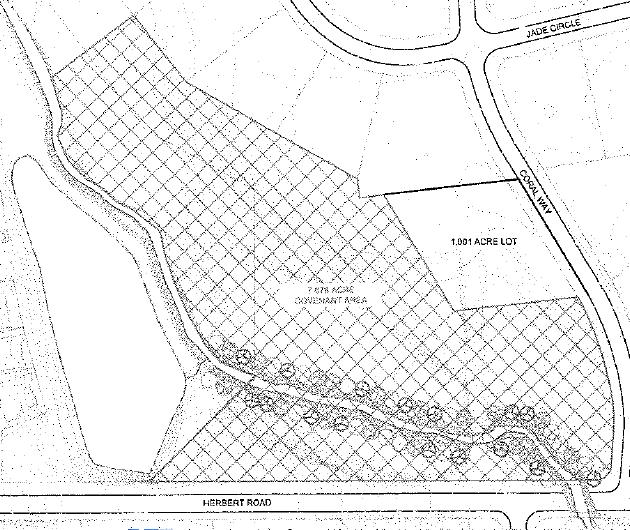
2011 map from Stonebridge Land Corporation shows current land plans.
The grid designates environmental covenant land in which the old cemetery was located.
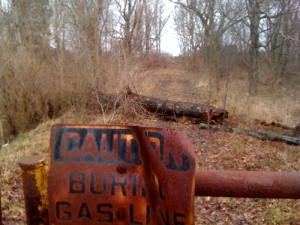
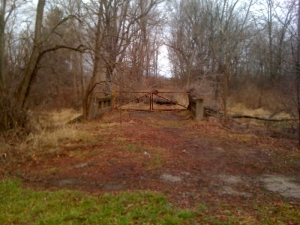
Pictures of Infirmary gate and drive and bridge at entryway to old Infirmary site
(Facing North from Herbert Road)


Rock wall at base of original cemetery location

Cemetery to the left (south) of the creek from Infirmary bridge
Saybrook Drive homes in background.
“Show me the manner in which a nation cares for its dead, and I will measure with mathematical exactness the tender mercies of its people, their respect for the laws of the land and their loyalty to high ideals.” William Gladstone

